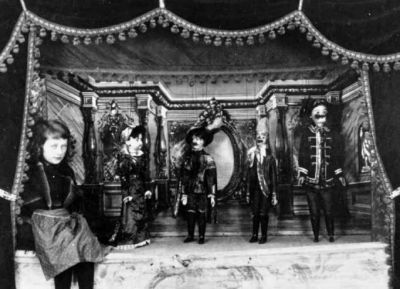
TRA UN MINUTO E TREMILA METRI. LE LUNGHEZZE STANDARD
LES ÉPINGLES (Francia/1913) R.: Léonce Perret. D.: 13'
F.: Georges Specht. Int.: Léonce Perret (Léonce), Suzanne Grandais (Suzanne), Émile Keppens (il dottore). Prod.: Gaumont. 35mm. L.: 269 m. D.: 13' a 18 f/s. Col. Didascalie inglesi / English intertitles. Da: EYE - Film Institute Netherlands(Desmet Collection)
PATHÉ JOURNAL SEPTEMBER 1913 (Gb/1913) D.: 5'
35mm. L.: 100 m. D.: 5' a 18 f/s. Col. Didascalie inglesi / English intertitles. Da: BFI National Archive
IN PERIL OF THE SEA (USA/1913) R.: George Loane Tucker. D.: 15'
Sog.: Jack Byrne. Int.: Matt Moore, Jane Gail, William J. Welsh, Carl Harbaugh. Prod.: IMP (Independent Moving Pictures Co. of America). 35mm. L.: 300 m. D.: 15' a 18 f/s. Bn. Didascalie inglesi / English intertitles. Da: BFI National Archive
UNDER SAVKLINGERS TAENDER (Danimarca/1913) R.: Holger-Madsen. D.: 40'
Sog.: Holger-Madsen, Laurids Skands. Int.: Alma Hinding, Holger-Madsen, Frederik Jacobsen, Torben Meyer, Svend Rindom. Prod.: Nordisk. 35mm. L.: 800 m. D.: 40' a 18 f/s. Bn. Didascalie inglesi / English intertitles. Da: BFI National Archive
ONÉSIME DÉBUTE AU THÉÂTRE (Francia/1913) R.: Jean Durand. D.: 6'
F.: Paul Castanet. Scgf.: Robert Jules Garnier. Int.: Ernest Bourbon (Onésime), Gaston Modot (comparsa), Berthe Dagmar (ballerina), Davrières (cameriera). Prod.: Gaumont. 35mm. L.: 118 m. D.: 6' a 18 f/s. Col. Didascalie olandesi / Dutch intertitles. Da: EYE - Film Institute Netherlands (Desmet Collection)
KASPERL-LOTTE (Germania/1913) R.: Emil Albes. D.: 13'
Sog.: Luise Heilborn-Körbitz. Int.: Hilde Müller, Lotte Müller. Prod.: Deutsche Bioscope GmbH. 35mm. L.: 277 m. D.: 13' a 18 f/s. Col. Didascalie tedesche / German intertitles. Da: Deutsche Kinemathek-Museum für Film und Fernsehen e EYE - Film Institute Netherlands (Desmet Collection)
Accompagnamento al piano di Antonio Coppola
Qualsiasi industria ottimizza costantemente le proprie linee di prodotti: le linee di successo rimangono in produzione e vengono ancora migliorate, mentre quel che non attira o non attira più i clienti sparisce dagli scaffali o dagli schermi. E ogni stagione porta qualcosa di nuovo sul mercato.
Nel 1913, la più antica lunghezza cinematografica standard restava una norma valida: era la lunghezza dei singoli segmenti dei newsreel. Duravano circa un minuto e consistevano in una o poche inquadrature, esattamente come i primi film degli anni 1895-1903. Ma l'ultimo grido, nel 1913, era il megafilm di 3000 metri o più. È vero che Les Misérables (3445 metri) venne mostrato in quattro parti nel gennaio 1913 e Les Trois Mosquetaires (3800 metri) in due serate di ottobre, ma Germinal (3000 metri, ovvero circa due ore e mezzo), sempre nell'ottobre 1913, passò in una sola proiezione.
Film di circa 2000 metri, come Quo Vadis?, L'Enfant de Paris e Ma l'amor mio non muore! divennero campioni d'incasso internazionali, e davanti al lungometraggio si spalancava ormai un grande futuro. Tuttavia la lunghezza media, per un film del 1913, era 318 metri, circa un quarto d'ora. E solo il 3% dei film prodotti in quell'anno superava i 1000 metri. (cfr. l'analisi di 3660 film proiettati nel 1913 in Francia, L'Année 1913 en France, a cura di Thierry Lefèbre, in "1895", hors serie 1993, pp. 205-216).
Chi l'avrebbe mai detto? Il 1913 fu un'epoca d'oro per i film brevi, con lunghezze di 120-150 metri come standard per i documentari e le scene comiche e gli one-reel di circa 300 metri come standard per i film di finzione, sia leggera sia drammatica. E certamente appartengono a questo standard, in uso ormai da diversi anni e dunque meglio affinato, i film più eleganti dell'epoca: perché i cineasti avevano acquisito l'esperienza necessaria e sapevano come concentrare ampie dosi d'azione, bellezza e sostanza narrativa in soli quindici minuti.
Mariann Lewinsky
Any industry is constantly optimising its product line-up: successful lines remain in production and are further improved and what does not appeal to customers, or no longer appeals, will disappear from the shelf or screen. And every season something brand new comes onto the market.
Thus in 1913 the earliest standard length for a film format was still a valid norm for newsreel items. These were about one minute long and consisted of one or just a very few shots, exactly like the earliest films of 1895-1903.
But the very latest thing in 1913 was the mega-film of 3000 m. or more. Les Misérables (3445 m.), it is true, was shown in four parts in January 1913 and Les Trois Mousquetaires (3800 m.) over two evenings in October, but Germinal (3000 m., i.e. two and a half hours) ran, also in October 1913, full length in a single session.
Films of around 2000 m. such as Quo Vadis?, L'Enfant de Paris and Ma l'amor mio non muore! became box office hits worldwide and the long feature film now had a great future before it. The average length, however, for a 1913 film, was 318 m., or about a quarter of an hour.
And only 3% of the films produced in 1913 were 1000 m. or longer. (See Thierry Lefèbre's analysis of 3660 films that ran in France that year, L'année 1913 en France, in "1895", hors serie 1993, pp. 205-216).
Who would have thought it? 1913 was a golden age for short films, with 120 m.-150 m. the norm for documentary and comedy scenes and the one-reeler of about 300 m. the standard length for both light-hearted and more serious fiction films. It is most certainly in this format, which had been used for some years and was therefore finely honed, that the most elegant films appeared, for the filmmakers had the necessary experience and knew how to pack a great deal of action, beauty and narrative into 15 minutes.
Mariann Lewinsky


Numero posti: 174
Aria Condizionata
Accesso e servizi per disabili
Il nostro cinema aderisce al circuito CinemAmico: è possibile utilizzare l’applicazione MovieReading® per i film di cui è prevista audiodescrizione e/o sottotitolazione sull'applicazione.
Tel. 051 2195311











